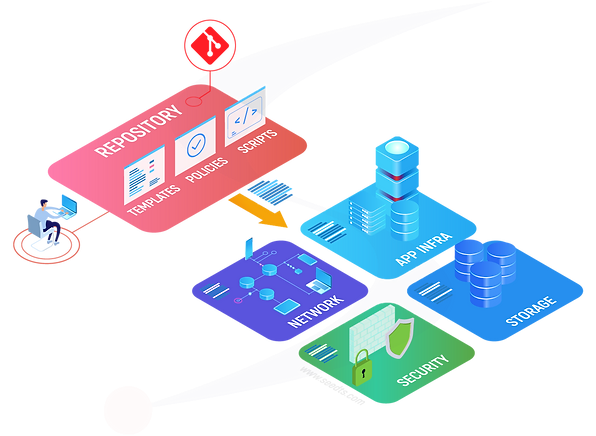
Introduction to Infrastructure as Code
The days of configuring your infrastructure by hand are over. Today, more and more infrastructure is deployed as code. Whether it’s HCL with Terraform, TypeScript with AWS CDK, or Python with Pulumi. This transition to Infrastructure as Code is happening fast and changing at a rapid pace. So the question becomes, why is Infrastructure as Code becoming so important? But also, why should a company invest its developers’ time in implementing this infrastructure?
Flashback
In the past, infrastructure management was a very time-consuming process. The servers had to be physically set up, configured and manually managed. Only once they were manually configured could software and applications be deployed. This process was slow, labor-intensive and expensive, and left a lot of room for human error. When outages occurred, technicians always had to be on site to diagnose and fix the problem, and due to inconsistencies in the initial configuration, this could become a complex and time-consuming process. Since the networks were not in the cloud, tools like server monitoring were not possible. But fortunately, that has changed in the meantime….
What is Infrastructure as Code?
Infrastructure as Code is a method of managing infrastructure configurations that allows the elements of an organization’s infrastructure to be stored in text files within a version control system. These text files contain the specifications of the infrastructure and facilitate editing, duplicating, and distributing configurations.

Using Infrastructure as Code helps to reduce or eliminate the need to manually perform infrastructure management and deployment processes. By providing these infrastructure configuration specifications as code and maintaining detailed version control notes, IaC eliminates undocumented ad hoc configuration changes and creates process consistency.
IaC helps reduce or eliminate environmental drift issues that are common in software development infrastructures. Cloud applications typically consist of networked resources in separate deployment environments for different phases of the release lifecycle. Environmental drift occurs when the infrastructure is not synchronized between development, staging, and production environments.
Infrastructure as Code (IaC) is an essential way to improve the security of your IT infrastructure. Because all configurations are defined as code and deployed from the cloud, IaC prevents the possibility of shadow IT in an organization and ensures that all changes are properly managed in a version control system and that all configurations are maintained in their desired state. Infrastructure as Code also enables infrastructure configurations to be standardized and scaled in an automated manner.

Frequently Asked Questions:
We often work for and with customers on various IaC projects in our day-to-day work. Especially at the beginning of a project, there tends to be a high demand for explanations about IaC. We have summarized our answers to the most frequently asked questions for you here:
- What are the advantages and disadvantages of Infrastructure as Code (IaC)?
- What is the difference between Infrastructure as a Service (IaaC) and Infrastructure as Code?
- Is Infrastructure as Code part of DevOps?
- Which service is right for us?

What are the advantages and disadvantages of Infrastructure as Code?
IaC helps to reduce or eliminate manual infrastructure management and deployment. By storing configurations in code and carefully versioning them, ad-hoc configuration changes are avoided and process consistency is created.
Infrastructure as Code also helps to improve security by preventing shadow IT from occurring in an organization and by properly managing all changes in a version control system. It also allows infrastructure configurations to be standardized and scaled automatically.
However, there are challenges to using IaC, such as ensuring code security, code compliance, and the difficulty in standardizing data transfers and security between different environments. However, these challenges can be overcome through careful backup strategies, varying access permissions, and clear visibility and monitoring of the entire infrastructure.
All in all, IaC offers a variety of benefits, including reduced costs and scalability of business processes, as well as improved visibility and control over the IT infrastructure.

What is the difference between Infrastructure as a Service (IaaS) and Infrastructure as Code (IaC)?
Infrastructure as a Service is a virtualized computing solution offered by cloud computing providers. IaaS is a fully cloud-based infrastructure system that gives you the ability to provision servers and storage, network firewalls and security, and occasionally even physical assets virtually over the Internet through third-party providers.
Infrastructure as Code is the management and provisioning of infrastructure through code rather than manual processes. By encoding and documenting your configuration in files and passing them to a version control system, IaC supports configuration management and helps avoid undocumented or unwanted changes.
Infrastructure as Code is closely tied to DevOps and cloud computing Infrastructure as a Service.

Is Infrastructure as Code Part of DevOps?
IaC is a key DevOps practice and a component of continuous delivery. With IaC, DevOps teams can work together with a unified set of practices and tools to rapidly and reliably deploy applications and their supporting infrastructure at scale.

Which Service is Right For Us?
Those who use only one cloud provider can use one of the provider-specific options. AWS, Azure, and GCP all offer a JSON-based tool, but its syntax and structure is not as accessible. That’s why there is now an abstraction on-top, which for Azure is Biceps and for AWS is CDK. CDK in particular, with a range of supported languages, allows you to more easily start directly with Infrastructure as Code. It then provides a CloudFormation template, which in return describes resources and dependencies. In addition, Terraform and Pulumi are also suitable for the single-cloud, if you are already familiar with them, especially with their state management, which you manage yourself via a remote state in one of the common cloud storages. In the case of multicloud scenarios, frameworks can be combined, but Terraform and Pulumi in particular allow easy provisioning to multiple cloud providers.
Images: Freepik, Srip, Ultimatearm

